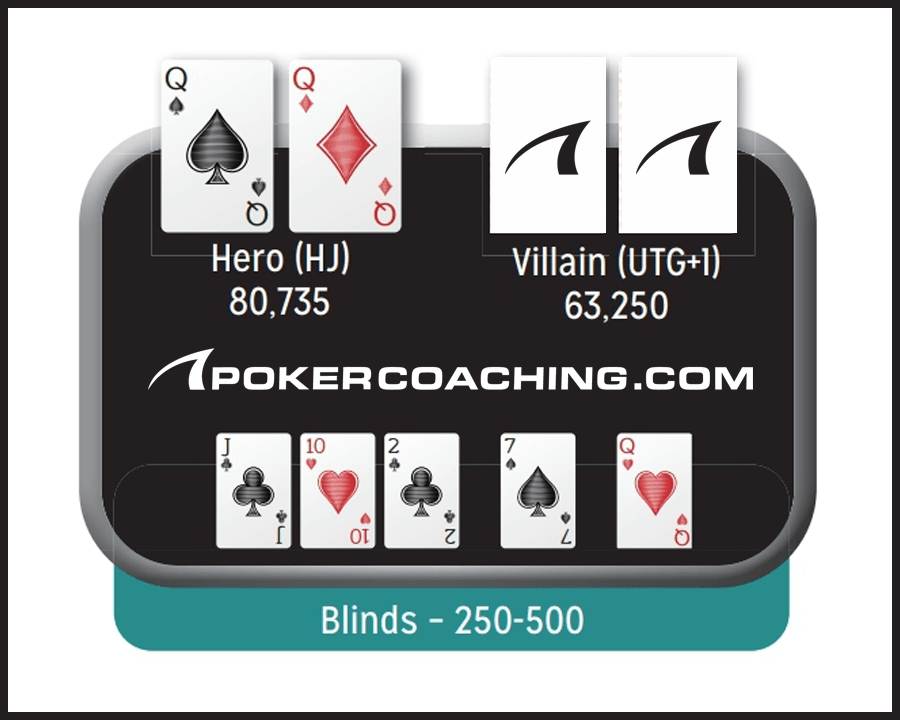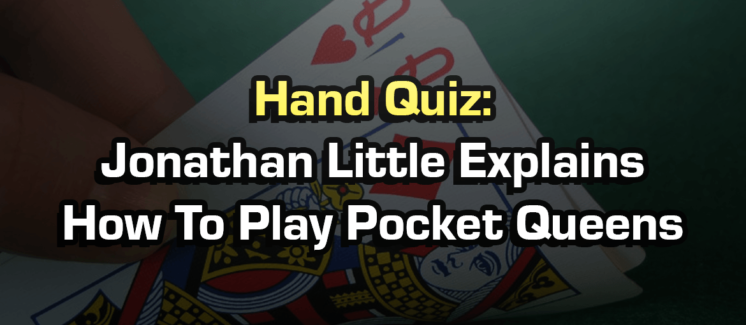Pocket queens are always beautiful to look down at at the poker table, especially when the flop doesn’t provide any kings or aces. Even when you get to play them as an overpair, it’s still important not to get out of line with your pocket queens. Study up, and be prepared to play double Q’s to perfection.
Scenario: You are eight-handed in a $5,000 buy-in online tournament. You have 80,735 chips with the blinds at 250-500 when a player in early position raises to 1,100. It folds to you in the hijack with pocket queens.

Preflop Analysis
Calling is a viable option only when you know for certain that the UTG+1 player is overly tight. Against everyone else, you should three-bet with the vast majority of your best hands for value. While you are somewhat deep stacked, 3,800 is too large of a bet from in position, making 3,200 the best size.
Action: You three-bet to 3,200 and only the initial raiser calls. The flop comes J♣-10♥-2♣ and your opponent checks.
Playing Pocket Queens As An Overpair
The Pot: 7,650
The Board: J♣-10♥-2♣
Effective Stack: 155 Big Blinds Effective
Flop Analysis
If this were a cash game where you do not especially mind if you get stacked, you should bet almost every time. In a tournament though, you should at least consider checking back because the jack and ten on the board connect well with your opponent’s range. Notice that your opponent can potentially have all the nut hands that beat your Q-Q. If you get check-raised, you cannot fold, but at the same time, you could easily be drawing to two outs with your entire stack on the line.
The prudent choice is to check behind in order to sidestep a potential set up situation in exchange for giving up a little value.
Action: You elect to check. The turn is the 7♠ and your opponent makes a pot-sized bet of 7,650.
Becoming a crusher at the table starts with crushing the fundamentals. Click here to see if you have what it takes.
Facing A Bet After A Safe Turn Card
The Pot: 15,300
The Board: J♣-10♥-2♣-7♠
Effective Stack: 155 Big Blinds Effective
Turn Analysis
Once you check behind on the flop, you should call any turn bet. Your opponent will often value bet with many jacks, and will at least consider bluffing with hands that have little-to-no showdown value. When you beat all the bluffs and some of the value bets, folding it out of the question.
Facing a large turn bet, raising does not make sense because again, if you are against a better hand, you want to minimize your losses.
Action: You elect to call. The river is the Q♥ and your opponent checks.
Rivering A Full House
The Pot: 22,950
The Board: J♣-10♥-2♣-7♠-Q♥
Effective Stack: 140 Big Blinds Effective
River Analysis
With this lucky queen on the river, you now have a hand strong enough to bet for value. Considering your opponent’s range, there are plenty of strong hands that would call a decent bet.
Overbetting for 24,000 is ill-advised because it will force many of your opponent’s marginal hands like a jack or ten to fold. Betting 8,000 will induce lots of calls, but with your newfound hand strength, you can likely get more value with a bigger bet. 16,000 is the best bet to make because it will likely get called by a wide range of your opponent’s likely marginal made hands.
Conclusion: You bet 16,000 and your opponent calls, revealing a flopped set of deuces. While you could have extracted more value from this exact hand on the river, you did well to not get all of the money in on an earlier betting round when you were drawing thin.
Improving at poker starts with studying of every possible spot you may face. If you enjoyed this hand quiz, check out the hundreds of hand quizzes offered to Poker Coaching members.



